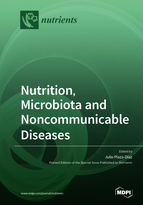Nutrition, Microbiota and Noncommunicable Diseases
A special issue of Nutrients (ISSN 2072-6643). This special issue belongs to the section "Prebiotics and Probiotics".
Deadline for manuscript submissions: closed (30 November 2019) | Viewed by 239059
Special Issue Editor
Interests: microbiota; cancer; metabolic disorders; gut microbiota; diet
Special Issues, Collections and Topics in MDPI journals
Special Issue Information
Dear Colleagues,
Health is defined as “the state of the organism when it functions optimally without evidence of disease”, and surprisingly, the words “microbes” or “microorganism” are missing in this definition. The regulation of gut microbiota is mediated by an enormous quantity of aspects, such as, microbiological factors, host characteristics, diet patterns and environmental variables. Some protective, structural and metabolic functions are reported for gut microbiota, and these functions are related to the regulation of homeostasis and host health. Host defence against pathogens is, in part, mediated through gut microbiota action and requires intimate interpretation of the current microenvironment and discrimination between commensal and occasional bacteria.
Prof. Dr. Julio Plaza-Díaz
Guest Editor
Manuscript Submission Information
Manuscripts should be submitted online at www.mdpi.com by registering and logging in to this website. Once you are registered, click here to go to the submission form. Manuscripts can be submitted until the deadline. All submissions that pass pre-check are peer-reviewed. Accepted papers will be published continuously in the journal (as soon as accepted) and will be listed together on the special issue website. Research articles, review articles as well as short communications are invited. For planned papers, a title and short abstract (about 100 words) can be sent to the Editorial Office for announcement on this website.
Submitted manuscripts should not have been published previously, nor be under consideration for publication elsewhere (except conference proceedings papers). All manuscripts are thoroughly refereed through a single-blind peer-review process. A guide for authors and other relevant information for submission of manuscripts is available on the Instructions for Authors page. Nutrients is an international peer-reviewed open access semimonthly journal published by MDPI.
Please visit the Instructions for Authors page before submitting a manuscript. The Article Processing Charge (APC) for publication in this open access journal is 2900 CHF (Swiss Francs). Submitted papers should be well formatted and use good English. Authors may use MDPI's English editing service prior to publication or during author revisions.
Keywords
- Microbiota or microbiome
- Nutrition
- Noncommunicable diseases
- Diet
- Probiotics
- Prebiotics
- Intestinal microbiota
- Health







